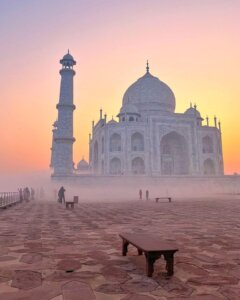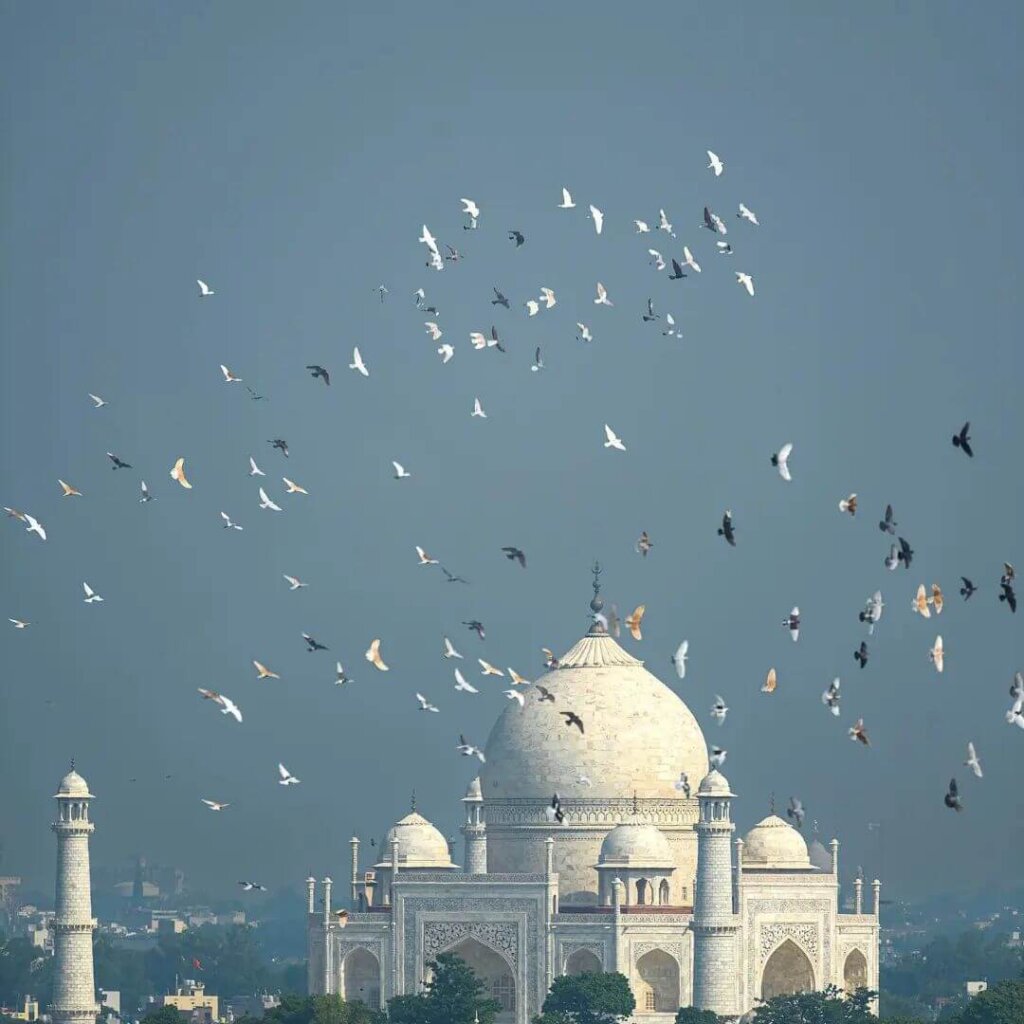“A Tale of Love and Architecture: Inside the Taj Mahal’s Enchanting ”
Introduction
Inside the Taj Mahal’s Enchanting as a symbol of love:

Inside the Taj Mahal’s Enchanting is renowned globally as an iconic symbol of love, thanks to the heart-touching story that inspired its creation. It was built by the Mughal emperor Shah Jahan in memory of his beloved wife Mumtaz Mahal, who tragically died during childbirth. Shah Jahan was extremely devoted to Mumtaz, and the Taj Mahal is a timeless testament to his enduring love for her. The story behind its creation is a touching tale of love, grief and the desire to immortalize a deep emotional connection.
Introduction of Inside the Taj Mahal’s Enchanting as an architectural marvel:
Beyond its famed romance, the Inside the Taj Mahal’s Enchanting allure lies in its architectural brilliance. Erected during the illustrious Mughal era, it showcases a harmonious fusion of Persian, Islamic, and Indian design elements. Crafted from pristine white marble, adorned with intricate carvings and precise geometric motifs, the Taj Mahal captivates with its timeless beauty. Every delicate detail and elaborate pattern contributes to its mesmerizing aesthetic. With its symmetrical layout and meticulous craftsmanship, it stands as a pinnacle of Mughal architectural mastery, earning global acclaim as one of the most extraordinary structures on earth.
The Love Story Inside the Taj Mahal’s Enchanting Halls
Historical context:
Begin by providing readers with an understanding of the historical context in which the Taj Mahal was built. Inside the Taj Mahal’s Enchanting was built in the city of Agra, India during the 17th century. The Mughal emperor Shah Jahan built this building in memory of his wife Mumtaz Mahal, who died during childbirth in 1631. Construction of the Taj Mahal began soon after his death, around 1632, and took about 22 years to complete, with contributions from many people. Workforce of skilled artisans and laborers.
Mughal Empire and Architectural Conservation:
Provide information about the cultural and historical importance of the Mughal Empire. Shahjahan, part of the Mughal dynasty, was known for his love of art and architecture. The Mughal rulers were great patrons of the arts, and their reign is characterized by the creation of many architectural marvels. In particular, Inside the Taj Mahal’s Enchanting represents the pinnacle of this patronage, demonstrating the empire’s commitment to artistic expression and grandeur.
Architectural Influence and Design:
Explore the architectural influences that shaped Inside the Taj Mahal’s Enchanting. The chief architect, Ustad Ahmed Lahauri, took inspiration from a variety of sources including Persian, Islamic and Indian architectural styles. The result is a unique synthesis of influences that contribute to the Taj Mahal’s distinctive appearance. Discuss key design elements, such as symmetrical layout, use of intricate carvings, and the inclusion of water features, gardens, and reflecting pools.

Cultural and symbolic importance:
Throw light on the cultural and symbolic importance of Inside the Taj Mahal’s Enchanting in the Mughal context. The Taj Mahal is not just a mausoleum; It is a symbol of love and devotion. The intricate details and artistic elements hold deep meanings, reflecting the Mughal worldview, which often integrated elements of spirituality, poetry and aesthetics.
Architectural Marvels: An Overview
Architectural Elements:
Inside the Taj Mahal’s Enchanting is a masterpiece of Mughal architecture, characterized by a harmonious blend of different architectural styles. Start by discussing its overall layout and structure. Inside the Taj Mahal’s Enchanting complex consists of the main mausoleum, a mosque, a guest house and vast gardens. The focal point is the white marble mausoleum with its iconic dome and four minarets.
Ingredients used:
Give details of the materials used in the construction of Inside the Taj Mahal’s Enchanting . The main construction material is white marble, quarried from Makrana, Rajasthan. This ancient marble not only gives the monument an ethereal appearance but also symbolizes purity and eternity. Other materials, such as precious and semi-precious stones, were used for intricate inlay work and decorative elements.
Symmetry and Balance:
Discuss the emphasis on symmetry and balance in the design of Inside the Taj Mahal’s Enchanting. The entire complex has been carefully crafted with precision, creating a symmetrical reflection in the central water channel. The main mausoleum is perfectly centered, and the surrounding structures, including the mosque and guest house, are positioned to maintain a sense of balance.
Central Dome:
Highlight the majestic central dome, one of the most striking features of Inside the Taj Mahal’s Enchanting. There is a lotus flower on the dome, which is a symbol of purity and divinity. Its size and proportions contribute to the overall visual impact of the monument. Discuss the optical illusion created by a slightly taller dome to give the impression of perfect symmetry when viewed from a distance.
Towers:
Explain the role of the four minarets located on the sides of Inside the Taj Mahal’s Enchanting. These slender towers are strategically located at each corner of the tomb to enhance its aesthetic appeal. Explore their architectural purpose, which goes beyond mere decoration, serving as symbolic elements and providing a sense of verticality to the structure.
Intricate Carvings and Inlays:
Admire the intricate carvings and inlays that adorn Inside the Taj Mahal’s Enchanting. The exterior features delicate floral patterns, calligraphy and geometric designs. The marble surfaces are decorated with semi-precious stones in intricate patterns, known as “pietra dura”. Explore the symbolic meaning behind these decorations and their importance in Mughal art.
Gardens and Water Features:
Briefly discuss the importance of surrounding gardens and water features. The gardens are built in the traditional Mughal charbagh style, divided into quadrilateral sections. The central water channel mirrors the mausoleum and contributes to the overall tranquility of the complex.
Entrance and Courtyard
Approaching the entrance:
As tourists approach the entrance to Inside the Taj Mahal’s Enchanting complex, the first impression is often a feeling of anticipation and awe. The journey generally begins from the main entrance, known as Darwaza-e-Rauza. Featuring a massive red sandstone structure with impressive architectural details, its grand entrance sets the tone for the entire experience.
Glimpse of Taj Mahal:
Passing through the main entrance, visitors get an early, breathtaking glimpse of the Taj Mahal from a distance. The monument, formed by the arches of the entrance, gradually reveals itself. The moment is often described as breathtaking, as the iconic shadow of the Taj Mahal appears against the backdrop of the sky.
Extensive courtyard:
As tourists proceed further, they enter the vast Mughal gardens built around the Taj Mahal. The huge courtyard, known as Charbagh, is a symmetrical paradise with carefully maintained walkways, lush greenery and strategically placed fountains. The sheer scale and well-plannedness of the garden contribute to a sense of grandeur and tranquility.
First glimpse of the main mausoleum:
The central path through the garden leads visitors to the main mausoleum. The Taj Mahal, with its gleaming white marble façade and distinctive dome, is gradually becoming more prominent. This gradual revelation heightens the anticipation and allows visitors to absorb the surrounding beauty before standing in the immediate presence of the monument.
Reflecting Pool:
Adjacent to the main tomb, visitors see a reflecting pond known as the Yamuna River. The symmetrical location of this water feature enhances the aesthetic appeal of the Taj Mahal and provides captivating reflections especially during sunrise and sunset. The pool contributes to the overall tranquility and visual harmony of the complex.
Effect of natural light:
This experience is further enhanced by the play of natural light on the marble surfaces. Depending on the time of day, tourists can see the Taj Mahal bathed in the pale colors of sunrise or sunset, creating a mesmerizing atmosphere. The interplay of light and shadow enhances architectural details and enhances the allure of the first impression.
Sensory Experience:
Beyond the visual aspects, first impressions involve a sensory experience. The fragrance of flowers, the sound of fountains and the overall atmosphere of the surroundings contribute to the overall experience with the Taj Mahal.
Main Mausoleum: Symbol of Eternal Love
Majestic Dome:
Architectural significance: The main mausoleum of the Taj Mahal is crowned with a majestic white marble dome. This dome is an amazing architectural feature both in terms of its size and intricate design. It represents the pinnacle of Mughal architecture and is one of the defining elements of the monument.
Symmetry and Proportion: Discuss how the dome is perfectly symmetrical and proportional, which contributes to the overall balanced aesthetic of the Taj Mahal. Its dimensions and curvature are carefully calculated to create a visually pleasing effect.
Lotus Finial: Highlight the lotus-shaped finial that adorns the top of the dome. The lotus is a symbol of purity and divinity in Indian culture, and its inclusion adds a spiritual and symbolic layer to the architectural design.
- Four beautiful towers:
Number and location: Explore the four towers located next to the main tomb. These minarets are located at each corner of the stage, providing a sense of verticality and framing the central structure. Discuss how their placement contributes to the overall balance of the monument.
Design and Architecture: Describe the architectural details of the minarets, such as their slender design and the ornate balconies that surround each level. Emphasize the intricate carvings and geometric patterns that adorn the minarets, which showcase the artistic prowess of Mughal artisans.
Practical and symbolic functions: Discuss the dual functions of the minarets. While minarets are traditionally used for prayer in Islamic architecture, in the case of the Taj Mahal, they are primarily decorative. However, they also serve a symbolic purpose, enhancing the visual appeal and religious colors of the monument.
- Inlay work and decorative elements:
Pietra Dura Technique: Dive deep into the exquisite inlay work that adorns the main tomb. Inside the Taj Mahal’s Enchanting is famous for its use of the pietra dura technique, where semi-precious stones are intricately carved and set into the marble to create vibrant and detailed patterns.
Floral motifs and calligraphy: Explore the floral motifs, geometric patterns and calligraphic inscriptions that adorn the exterior of the tomb. Each element has been carefully crafted, contributing to the overall aesthetic richness and cultural significance of the Taj Mahal.
- Effect of light and shadow:
Day and Night Changes: Discuss how the domes and minarets undergo changes throughout the day. The play of sunlight on the marble surfaces produces different colors, making the monument appear particularly magical during sunrise and sunset. Additionally, the soft lighting during the night enhances the ethereal beauty of the Taj Mahal.
Intricate Interiors: Halls and Chambers
Entrance to the main tomb:
Gateway of Tranquility: As tourists walk through the main entrance of Inside the Taj Mahal’s Enchanting, they are greeted by a serene atmosphere. The transition from exterior grandeur to interior is marked by a sense of peace, setting the stage for a more intimate experience.
- Central Hall:
Architectural Splendor: Explore the Central Hall, which houses the tombs of Shahjahan and Mumtaz Mahal. Describe the architectural splendor of the interior, including intricate carvings, floral patterns and continuity of the pietra dura technique.
Cenotaphs and Decorations: Detail of the cenotaphs (symbolic tombs) of Shah Jahan and Mumtaz Mahal, which are beautifully decorated with delicate marble inlays. Explain the significance of the floral motifs and calligraphic inscriptions that adorn the surfaces.
- Surrounding Rooms:
Mumtaz Mahal’s Room: Take readers to the room where Mumtaz Mahal’s tomb is located. Explore the artistic representations and inscriptions that pay tribute to his memory. Discuss the atmosphere of reverence and love prevalent in this place.
Shahjahan’s Chamber: Provides information about Shahjahan’s Chamber, where his tomb is located next to Mumtaz Mahal. Discuss any unique features, artistic elements or inscriptions that distinguish this area.
- Play of Light and Shadow:
Natural Light: Emphasize the effect of natural light filtering through intricately designed lattice (jali) screens, creating dancing patterns on the marble surfaces. Explain how the play of light and shadow adds a dynamic and ethereal quality to interior spaces, especially during different times of the day.
Additional Tips and Recommendations
Best time to visit:
Early morning or late afternoon:
It is recommended to visit the Taj Mahal during the early morning or late afternoon for best lighting conditions.
Light sunlight during sunrise or sunset enhances the beauty of the monument and provides excellent opportunities for photography.
Avoiding crowds:
Suggest visiting on weekends and weekdays during non-peak season to avoid large crowds.
Mornings are generally cooler and offer a more serene experience.
Ticket Information:
On normal working days Inside the Taj Mahal’s Enchanting opens 30 minutes before sunrise and closes 30 minutes before sunset. It is closed on Fridays for general darshan, but is open on all other days.
Ticket Outlet:
Tickets can be purchased from various gates:
West Gate: Tickets are available one hour before sunrise and 45 minutes before sunset near Saheli Burj.
East Gate: Tickets are available one hour before sunrise and 45 minutes before sunset.
South Gate: No entry, only exit allowed.
entrance fees:
Foreign tourists: ₹1100 + ₹200 (optional) to visit the main tomb.
Citizens of SAARC and BIMSTEC countries: ₹540 + ₹200 (optional) for visiting the main mausoleum.
Domestic/Indian/OCI cardholders: ₹50 + ₹200 (optional) for visiting the main tomb.
Those buying tickets online get a discount of ₹5 on Indian tickets and ₹50 on foreign tickets.
No entry fee for children below 15 years of age.
An additional fee of ₹200 will be charged to visit the main mausoleum.
Buying Taj Mahal Tickets Online:
To save time and avoid long queues at ticket counters, visitors are encouraged to purchase tickets online through the official websites asi.payumoney.com and www.asiagracircle.in.
Access Restrictions and Security:
Prohibited Items: Visitors are informed about items that are not allowed Inside the Taj Mahal’s Enchanting, such as large bags, food and tripods.
Security Check: It is advisable to arrive well in advance, as security check may take some time. Collaboration with security personnel ensures a smooth entry process.
Dress Code and Comfort:
Casual Clothing: In view of the cultural significance of the site, visitors are advised to wear modest and comfortable clothing.
Shoes: Shoes must be removed before entering the main tomb. Easily removable shoes are recommended for convenience.
Photography Guidelines:
No tripods inside the mausoleum: No tripods are allowed inside the main mausoleum. Visitors are encouraged to take photographs outside the monument handheld and using a tripod.
Respectful Photography: Respectful photography is emphasized, especially in sensitive areas such as the main hall. The use of flash photography is discouraged to protect the delicate interiors.
Guided tours and information:
Guided Tours: Visitors are suggested to consider guided tours for a more informative experience. Knowledgeable guides can provide historical context, interesting facts, and navigate through the complex.
Information Centers: Visitors are informed about the information centers on site, where they can obtain additional information about the history, architecture, and conservation efforts of Inside the Taj Mahal’s Enchanting.
environmental awareness:
Waste Disposal: Responsible waste disposal using designated bins is encouraged. Visitors should avoid littering to contribute to the conservation and cleanliness of the site.
Respecting heritage: Visitors are reminded to respect the heritage site by avoiding touching or leaning on delicate surfaces.
Closing Thoughts
Final thoughts on the enduring story:
In concluding our journey through the enchanting halls and gardens of Inside the Taj Mahal’s Enchanting, it is impossible to escape a deep sense of awe and admiration for the enduring story of love and architectural splendor that this iconic monument encapsulates.
Symbol of eternal love:
At its core, Inside the Taj Mahal’s Enchanting stands as a testament to love in its purest and most enduring form. Built by Mughal emperor Shah Jahan in memory of his beloved wife Mumtaz Mahal, this monument immortalises a love story beyond time. The walls seem to echo with the echoes of a bygone era, echoing the love that inspired its creation.
Architectural Wonders:

Beyond its role as a symbol of love, Inside the Taj Mahal’s Enchanting is an architectural marvel that continues to fascinate the hearts and minds of all who visit it. The precision of its symmetry, the intricacy of its carvings, and the ethereal beauty of its white marble facade are testament to the genius of the artisans and architects who brought this vision to life. Each minaret, each arch and each delicate inlay tells a story of skill, dedication and commitment to perfection that has stood the test of centuries.
Timeless Elegance:
As the sun sets and casts its warm hues over Inside the Taj Mahal’s Enchanting, one cannot avoid reflecting on the timeless elegance that defines this monument. The changing play of light and shadow on its surfaces adds another layer to its beauty, as if the monument itself is a living canvas, displaying different facets of its grandeur with every passing moment.
Legacy of the Mughal Empire:
Inside the Taj Mahal’s Enchanting is not just a single structure; It is a living legacy of the cultural richness and architectural prowess of the Mughal Empire. It reflects an era where art, science and spirituality combined to create monuments that transcend their physical existence and become symbols of the grandeur of civilization.
To cherish and preserve heritage:
In exploring Inside the Taj Mahal’s Enchanting, we are reminded of our collective responsibility to cherish and preserve our cultural heritage. Conservation efforts to protect the monument from environmental threats underscore the importance of protecting these treasures for future generations. It is a call to action, urging us to become stewards of our history and guardians of the stories carved in stone.
A timeless journey:
As we stand in the shadow of Inside the Taj Mahal’s Enchanting, its white marble gleaming in the moonlight, we become part of a timeless journey – a journey of love, artistry and the enduring discovery of beauty. The Taj Mahal invites us to transcend the boundaries of time and immerse ourselves in the rich tapestry of human history, where emotions are carved in stone and where architectural splendor becomes a medium to immortalize the deepest human experiences.

